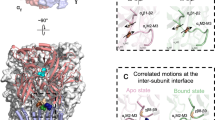Abstract
The structure–function relationship of the nicotinic acetylcholine receptor (AChR) has been effectively studied by the combination of complementary DNA manipulation and single-channel current analysis1–6. Previous work with chimaeras between the Torpedo californica and bovine AChR δ-subunits has shown that the region comprising the hydrophobic segment M2 and its vicinity contains an important determinant of the rate of ion transport through the AChR channel5. It has also been suggested that this region is responsible for the reduction in channel conductance caused by divalent cations5 and that segment M2 contributes to the binding site of noncompetitive antagonists7,8. To identify those amino acid residues that interact with permeating ions, we have introduced various point mutations into the Torpedo AChR subunit cDNAs to alter the net charge of the charged or glutamine residues around the proposed transmembrane segments9–15. The single-channel conductance properties of these AChR mutants expressed in Xenopus laevis oocytes indicate that three clusters of negatively charged and glutamine residues neighbouring segment M2 of the α-, β-, γ- and δ-subunits, probably forming three anionic rings, are major determinants of the rate of ion transport.
Similar content being viewed by others
References
Mishina, M. et al. Nature 307, 604–608 (1984).
Mishina, M. et al. Nature 313, 364–369 (1985).
Sakmann, B. et al. Nature 318, 538–543 (1985).
Mishina, M. et al. Nature 321, 406–411 (1986).
Imoto, K. et al. Nature 324, 670–674 (1986).
Tobimatsu, T. et al. FEBS Lett. 222, 56–62 (1987).
Giraudat, J., Dennis, M., Heidmann, T., Chang, J.-Y. & Changeux, J.-P. Proc. natn. Acad. Sci. U.S.A. 83, 2719–2723 (1986).
Hucho, F., Oberthür, W. & Lottspeich, F. FEBS Lett. 205, 137–142 (1986).
Noda, M. et al. Nature 299, 793–797 (1982).
Noda, M. et al. Nature 301, 251–255 (1983).
Noda, M. et al. Nature 302, 528–532 (1983).
Claudio, T., Ballivet, M., Patrick, J. & Heinemann, S. Proc. natn. Acad. Sci. U.S.A. 80, 1111–1115 (1983).
Devillers-Thiery, A., Giraudat, J., Bentaboulet, M. & Changeux, J.-P. Proc. natn. Acad. Sci. U.S.A. 80, 2067–2071 (1983).
Guy, H. R. Biophys. J. 45, 249–261 (1984).
Finer-Moore, J. & Stroud, R. M. Proc. natn. Acad. Sci. U.S.A. 81, 155–159 (1984).
Brisson, A. & Unwin, P. N. T. Nature 315, 474–477 (1985).
Takai, T. et al. Nature 315, 761–764 (1985).
Takai, T. et al. Eur. J. Biochem. 143, 109–115 (1984).
Witzemann, V., Barg, B., Nishikawa, Y., Sakmann, B. & Numa, S. FEBS Lett. 223, 104–112 (1987).
Shibahara, S. et al. Eur. J. Biochem. 146, 15–22 (1985).
Yu, L., LaPolla, R. J. & Davidson, N. Nucleic Acids Res. 14, 3539–3555 (1986).
Boulter, J. et al. J. Neurosci. Res. 16, 37–49 (1986).
Boulter, J. et al. Nature 319, 368–374 (1986).
Schofield, P. R. et al. Nature 328, 221–227 (1987).
Grenningloh, G. et al. Nature 328, 215–220 (1987).
Kubo, T. et al. Eur. J. Biochem. 149, 5–13 (1985).
Zoller, M. J. & Smith, M. Meth. Enzym. 100, 468–500 (1983).
Nakamaye, K. L. & Eckstein, F. Nucleic Acids Res. 14, 9679–9698 (1986).
Melton, D. A. et al. Nucleic Acids Res. 12, 7035–7056 (1984).
Methfessel, C. et al. Pflügers Arch. ges. Physiol. 407, 577–588 (1986).
Author information
Authors and Affiliations
Rights and permissions
About this article
Cite this article
Imoto, K., Busch, C., Sakmann, B. et al. Rings of negatively charged amino acids determine the acetylcholine receptor channel conductance. Nature 335, 645–648 (1988). https://doi.org/10.1038/335645a0
Received:
Accepted:
Issue Date:
DOI: https://doi.org/10.1038/335645a0
- Springer Nature Limited
This article is cited by
-
Structural principles of distinct assemblies of the human α4β2 nicotinic receptor
Nature (2018)
-
Alcohol reduces muscle fatigue through atomistic interactions with nicotinic receptors
Communications Biology (2018)
-
The unanticipated complexity of the selectivity-filter glutamates of nicotinic receptors
Nature Chemical Biology (2012)
-
Rotamers affect ion conductance
Nature Chemical Biology (2012)





